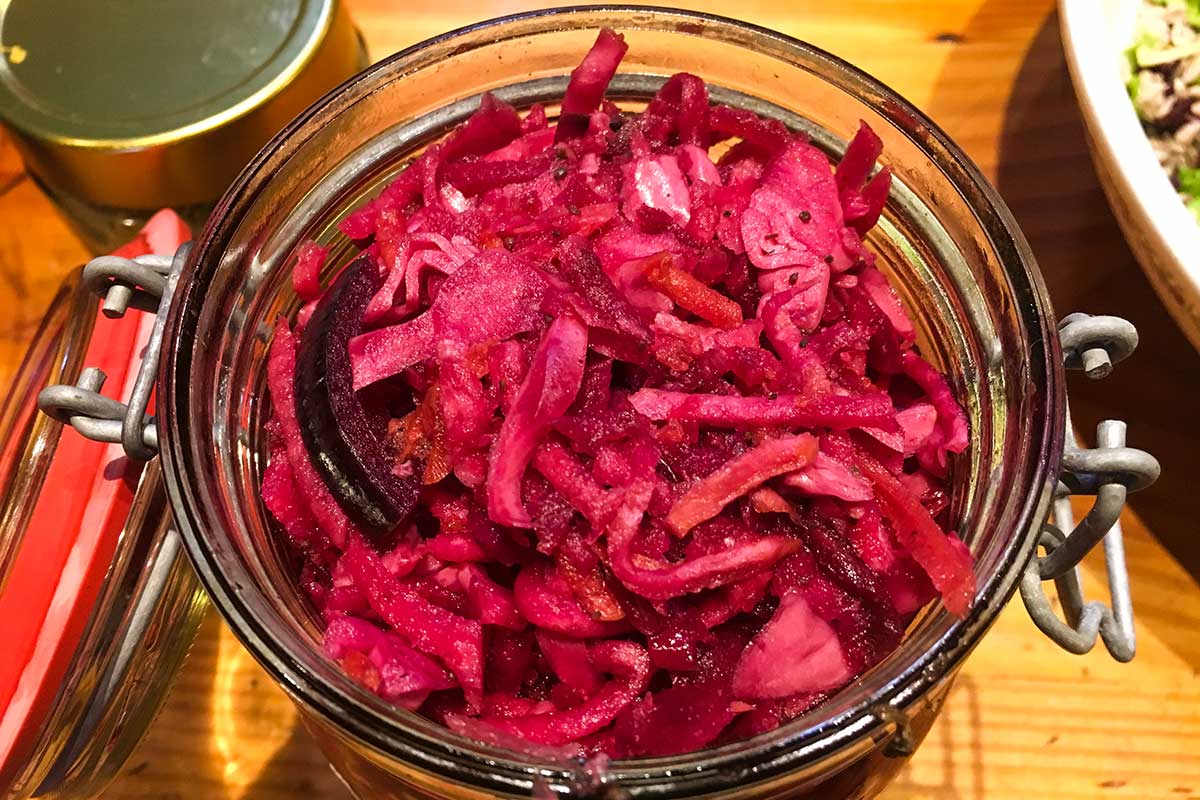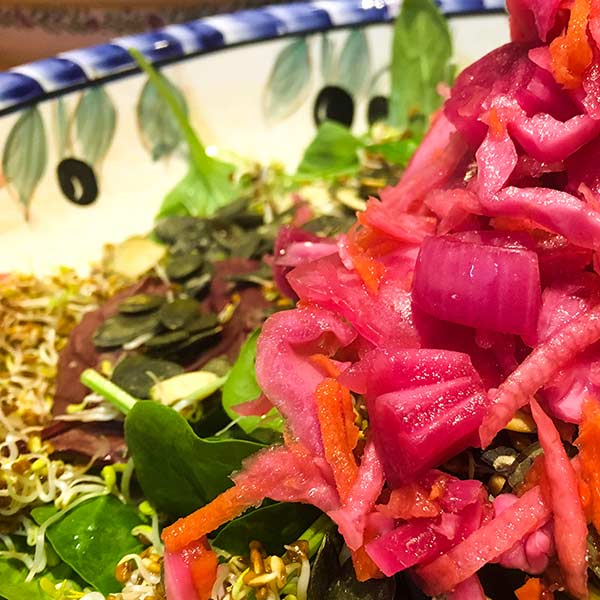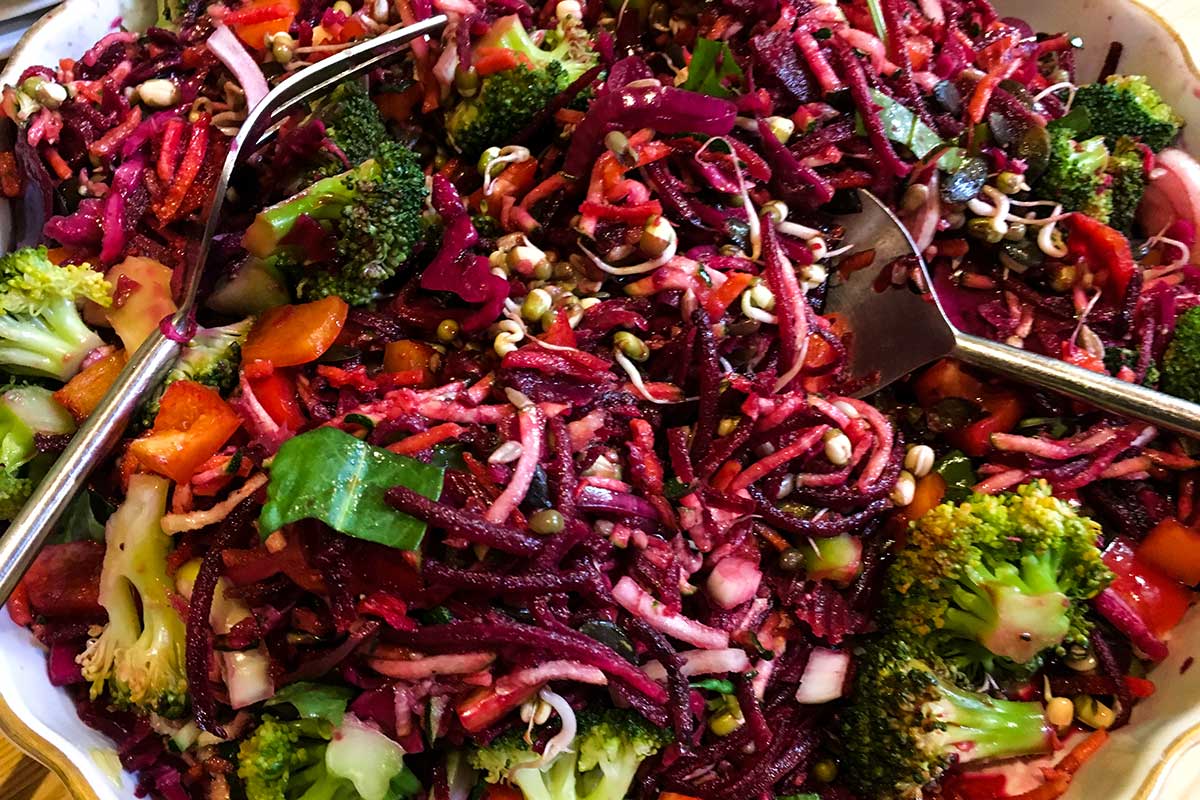
Experimentation in Fermentation
Lacto-fermenting is one of those amazing processes in nature and real kitchen magic. Kimchi (that’s the Korean version), krauts (including saurkaraut) Kvaas or fermented vegetables are the most miraculous way of preparing a probiotic and prebiotic fermented food that I have come across.
It is a simple way of creating a lactobacillus rich food from raw vegetables and the best thing for healthy guts I have encountered. This method also means you can prepare enough vegetables for a week or two all in one go.
In the autumn one of the students turned up with a big bag of veg so we decided to experiment with root ferments for the winter. Soon we will be doing ones from fresh greens, herbs and stuff from the garden and around. One can also use this method to preserve herbs for use over the winter.
Kimchi is
Delicious

So basically, one chops, grates or slices the vegetables. Initially, we made one from kale and beetroot with onions and another from onions, celeriac and carrots. Other things we have used over the winter include red cabbage, peppers and swede. Jerusalem artichokes, mooli, radish gobo (burdock root), wild green and lots of other things can be used.
One can do a single vegetable ferment such as tomatoes, gherkins, carrots or beetroot or cabbage. You can use just about anything. So you prepare the vegetables, then put them into a pyrex bowl and cover them with brine (2-3 tablespoons of sea salt dissolved per 1 litre of water). Some people feel you should use spring water or chlorine free water, or you can just boil water and allow it to cool to remove most of the chlorine; we just use water straight from the tap and it seems to work fine.
Then put a plate on top of the vegetables and weigh it down (I just stand a mason jar of lentils on top). Leave it overnight then strain off the vegetables, saving the brine. Mash about 5 cloves of garlic, grate about 2-3 tablespoons of fresh ginger (or you can use ginger powder), mix these together and add 1-2 teaspoons of chilli powder and mix into a paste with some of the brine; we also add some fennel or celery seed and one could add turmeric or cumin or coriander seed, or juniper berries.
Cinnamon seems to inhibit the fermentation so is best not used. You could probably add other herbs and spices too. Stir the paste through the vegetables and pack them into a Kilner/mason jar and cover with the saved brine. Cover with a square of muslin and keep in warm place, stirring daily to ensure all the vegetables stay submerged.
Taste each day until it is sufficiently fermented, it will start to taste slightly vinegary. When sufficiently fermented put into closed jars and store in the fridge.
Alternatively ...
Use a sauerkraut or kimchi crock. Salt induces a Lacto-fermentation from the lactobacilli naturally present in the atmosphere and on the vegetables. This also explains why some salt is necessary for the diet to balance our gut flora and encourage proper break down of vegetables (its one of the reasons why ruminants like cows and horses benefit from salt licks). Hope that explains the process properly, it’s really easy and the finished vegetables can be added to soups, stir-fries, sandwiches, stirred through rice or barley or other grains or added to salads.
Krautchi Recipe
(similar to sauerkraut, the salt is massaged through the vegetables rather than using the brine):
1 red cabbage, 2 carrots, 1 apple, 1 chilli, 8 juniper berries, 2 tsp coriander seeds. 3 tbsp coarse seed salt, 200 ml water.
Slice red cabbage into 8 wedges after discarding any bruised or wilted out leaves then slice into thin shreds. Peel and grate the carrots and apple.
Finely chop the chilli. Place the veg into a clean pyrex bowl and massage the sea salt through them with clean hands for 5 minutes.
Rest and repeat again after another 5 minutes. Add the juniper berries and coriander seed. Cover with a close-fitting plate and weigh down. Leave in a cool dark room for 24 hours at which point the veg should be covered with brine.
Add more brine if necessary at this stage. Leave to ferment for 3-5 days and transfer to a sterilized jar for storage.
Useful sources of recipes ...
Recommended books ...
Fermented vegetables: Creative recipes for fermenting 64 vegetables and herbs Kirsten Shockey and Christopher Shockey
Fermenting Daphne Lambert
Wild Fermentation Sandor Katz
Kefir ...
Kefir can be prepared in milk or water, an article on Kefir is coming soon.

Nikki's Website: veriditashibernica.org